Description
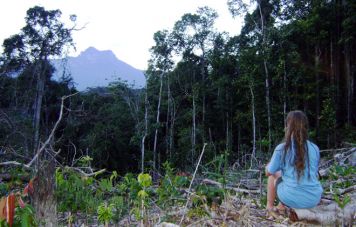 “Amazon Neblina Tours” is a subdivision and the regional organization of Southern Cross Tours which in turn is a division of Southern Cross Tours & Expeditions. Among a variety of tours focusing on nature, cultural and social aspects in Brazil's wild and unknown back country, it is the journey to Brazil's highest mountain, the 2,994 m.s.l. Pico da Neblina, located amidst the Amazonian rainforest, that is the most demanding – and the most rewarding – for the experienced traveler and hiker. As the only outfitter with an own operational basis in São Gabriel da Cachoeira, we offer to the demanding traveler the best option for expeditions and tours into the deep forest by putting safety and content as top priorities.
“Amazon Neblina Tours” is a subdivision and the regional organization of Southern Cross Tours which in turn is a division of Southern Cross Tours & Expeditions. Among a variety of tours focusing on nature, cultural and social aspects in Brazil's wild and unknown back country, it is the journey to Brazil's highest mountain, the 2,994 m.s.l. Pico da Neblina, located amidst the Amazonian rainforest, that is the most demanding – and the most rewarding – for the experienced traveler and hiker. As the only outfitter with an own operational basis in São Gabriel da Cachoeira, we offer to the demanding traveler the best option for expeditions and tours into the deep forest by putting safety and content as top priorities.
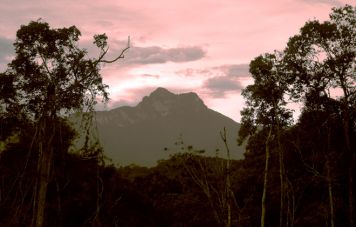 Situated in the Imeri massif, in the federal state of Amazonas, the Pico da Neblina borders with Venezuela on its northern slope, and is part of the 22,000 km² Parque Nacional do Pico da Neblina. The national park is located between 01º 10' and 03º 02' northern latitude and 65º 03' and 66º 52' western longitude and is of difficult access. The participants of our expedition will make the experience of their life, when they encounter the untouched and untamed tropical rainforest, its enormous spectrum of species and its complex form of life and interactions in flora and fauna. The natural attractions include the igapós, flooded rainforests of the lowlands, the várzea forest with its fertile grounds, the terra firme with its enormous biodiversity (215 species of hard-wood trees alone) and also the nebular forest at the Pico da Neblina, where the richness of epiphytes, orchids and bromeliads, is just breathtaking, thus compensating the nature lover for the strenuous trail up to the “Pico”.
Situated in the Imeri massif, in the federal state of Amazonas, the Pico da Neblina borders with Venezuela on its northern slope, and is part of the 22,000 km² Parque Nacional do Pico da Neblina. The national park is located between 01º 10' and 03º 02' northern latitude and 65º 03' and 66º 52' western longitude and is of difficult access. The participants of our expedition will make the experience of their life, when they encounter the untouched and untamed tropical rainforest, its enormous spectrum of species and its complex form of life and interactions in flora and fauna. The natural attractions include the igapós, flooded rainforests of the lowlands, the várzea forest with its fertile grounds, the terra firme with its enormous biodiversity (215 species of hard-wood trees alone) and also the nebular forest at the Pico da Neblina, where the richness of epiphytes, orchids and bromeliads, is just breathtaking, thus compensating the nature lover for the strenuous trail up to the “Pico”.
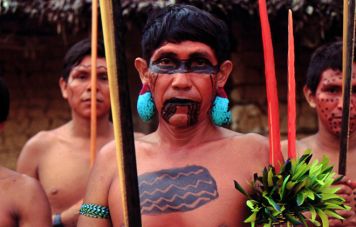 The target region is a totally isolated area with difficult access. The largely non-existence of human activities in the region, such as agriculture, stock farming, timber, mining, etc., except some subsistence activities including of small farmers and those of the Yanomami tribes, guarantees untouched nature and an undamaged ecosystem. The region hosts also the biggest Yanomami Indian reservation in Brazil.
The target region is a totally isolated area with difficult access. The largely non-existence of human activities in the region, such as agriculture, stock farming, timber, mining, etc., except some subsistence activities including of small farmers and those of the Yanomami tribes, guarantees untouched nature and an undamaged ecosystem. The region hosts also the biggest Yanomami Indian reservation in Brazil.
As the only tour operator so far and to add still more value to our Neblina expedition, we have included a guaranteed stay at one of the Yanomami villages. We have also created the NOTIWA – Future Yanomami Fund, into which 200 US$ per traveler has to be paid to ensure health and education of the Yanomami children.
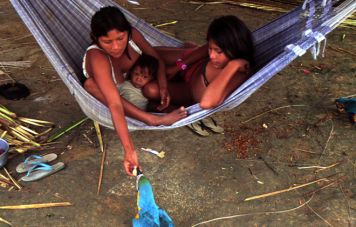 The Yanomamis cover an area of 96,650 km² in Brazil alone and number a population of 15,682 in the Federal States of Amazonas and Roraima, with approximately the same in size and population on the Venezuelan sides of both states. Hunters and farmers of the tropical rain forest, as they have always been, they faced, as many other tribes in Brazil and elsewhere, invasion of their territory by the timber industry, gold diggers, farming, plagues.
The Yanomamis cover an area of 96,650 km² in Brazil alone and number a population of 15,682 in the Federal States of Amazonas and Roraima, with approximately the same in size and population on the Venezuelan sides of both states. Hunters and farmers of the tropical rain forest, as they have always been, they faced, as many other tribes in Brazil and elsewhere, invasion of their territory by the timber industry, gold diggers, farming, plagues.
Very self-confident and autonomous in their decisions, they are very articulated and well organized in their dealings with the federal government agencies, namely FUNAI. The Yanomami call their environment “urihi”, the forest-land, which to them is not an inert space, what we call nature, serving to sheer economic exploration. But instead they consider it a living entity integrated in a complex cosmologic – dynamic of interchange of humans and no humans. As such it finds itself today threatened by blind predation of the white man. As the visionary leader Davi Copenawa Yanomami alerts:
“The forest-land only can die if destroyed by the white man. Than, rapids will disappear and the earth and trees will dry and stones and mountains will split from the heat. The xapiripë spirits that live in the highlands and play in the forest will finally escape and their fathers, the shamans, can not call upon them anymore to protect us. The forest-land becomes dry and empty. The shamans will not be able to repel and to detain the smoke epidemics and the bad beings which bring us illness. This way, everybody will die.”
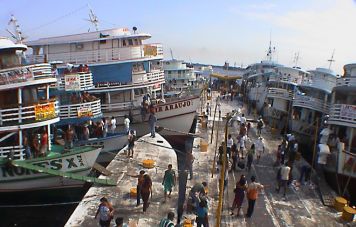 We consider a day in Manaus the capital of the federal state of Amazonia, important to understand past and presence of the development of the region. Starting point of the expedition however is the town of São Gabriel da Cachoeira (SGC), a military settlement and Salesian mission, right at the banks of the upper Rio Negro River. SGC is within reach by boat or plane (turboprop) from Manaus. Some 85 km of slick and tricky dirt road leads to the pier of the Ia-mirim river and requires four-wheel-drive and a top driver. To drive on this road during rainy days even a 4 wheel driven jeep needs extra manpower to make it through the mud. Two days on the Ia and Cauaburi rivers are needed to get to the mouth of the Tucano river, from where the expedition continues on foot (36 km). The Pico da Neblina peak will be reached after another five days.
We consider a day in Manaus the capital of the federal state of Amazonia, important to understand past and presence of the development of the region. Starting point of the expedition however is the town of São Gabriel da Cachoeira (SGC), a military settlement and Salesian mission, right at the banks of the upper Rio Negro River. SGC is within reach by boat or plane (turboprop) from Manaus. Some 85 km of slick and tricky dirt road leads to the pier of the Ia-mirim river and requires four-wheel-drive and a top driver. To drive on this road during rainy days even a 4 wheel driven jeep needs extra manpower to make it through the mud. Two days on the Ia and Cauaburi rivers are needed to get to the mouth of the Tucano river, from where the expedition continues on foot (36 km). The Pico da Neblina peak will be reached after another five days.
Flora & Fauna
Scientific Importance
Beyond the scenic beauty of Brazils highest peak, it is the scientific importance of the Pico da Neblina National Park, that has been pointed out by many famous scientists like De Spruce, McGuire, Froes, Vanzoline, Prance, Pires and others, as being absolutely spectacular.
The high camps of the Pico da Neblina hosts the highest known endemic density of all Brazilian highland formations and about 50 % of the undiscovered species are completely unknown territory for the science. Without a doubt, here, the future will reveal a new world, especially in botany.
Some of the animals and plants, which can be observed in the region:
Birds
Blue and yellow chested macaw, scarlet macaw, green winged macaw
Spiders
Such as the non poisonous Theraposa leblondi, the biggest spider of the world, with a lifespan of up to 20 years, the very poisonous Loxoceles, Phoneutria and Lycosas, Latraodectus mactans (black widow)
Mammals
Tapir, capybara, giant otter, paca, brown and black howler monkey, black uacari, spider monkey, dusky titi monkey, brown capuchin monkey, spider monkey, sloth, river dolphin
Fish
Piracurú, piranha, ornamental fish
Reptiles
Caiman, several kinds of poisonous snakes, iguanas, turtles
Amphibians
Dart-poison frogs (Dendrobatidae)
Butterflies
Papillion, heliconius, morphs
Orchids, Bromeliads, Trees
Paechmea aquilega, Scuticarias, Coriantes, Cataseto, carnivorous such as Hellianphora tatei, brachinnia, drosera and utricularias, caoutchouc trees (Hevea brasiliensis), Brazil-nut trees (Bertholletia excelsia), assaí and buriti palms
and many, many, more...
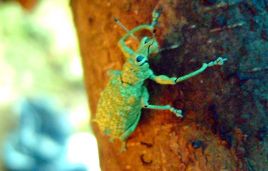 | 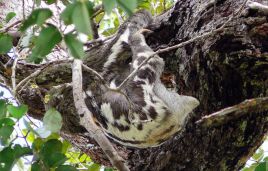 | 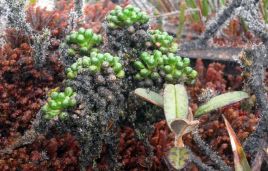 |
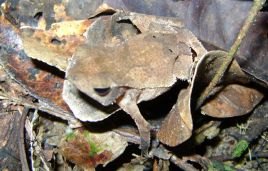 | 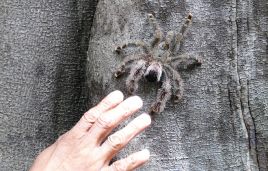 | 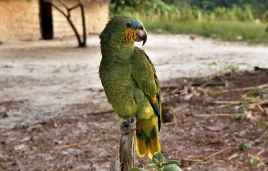 |
Day 1-7
Itinerary
Day 1
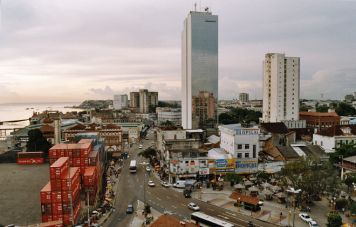 Flight to Manaus with arrival estimated around noon and transfer to the hotel. After lunch the group starts for a sightseeing tour. Manaus is the gateway to the inner Amazon region and has been of significant importance for the conquest of the whole region, a fact for which the jungle theater and the harbor, included in our city tour, deliver rich testimony. With time left, we visit the confluence of the Rio Negro and Solimões rivers that form the great Amazon river.
Flight to Manaus with arrival estimated around noon and transfer to the hotel. After lunch the group starts for a sightseeing tour. Manaus is the gateway to the inner Amazon region and has been of significant importance for the conquest of the whole region, a fact for which the jungle theater and the harbor, included in our city tour, deliver rich testimony. With time left, we visit the confluence of the Rio Negro and Solimões rivers that form the great Amazon river.
Day 2
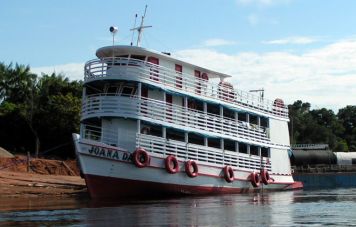 Early departure with Trip Linhas Aéreas to São Gabriel da Cachoeira, located on the upper Rio Negro. The group is welcomed by our operation manager Henrique Leão “Branco”. Transfer to the hotel. During a stroll through the small town the permits from the national park authority and the FUNAI will be collected. After returning to the hotel, the equipment and baggage will be checked and packed up for departure next day. In the late afternoon the outboard engine will be checked on a ride through the rapids of the Rio Negro. During the dinner the complete crew and participants will get acquainted. Overnight in São Gabriel da Cachoeira.
Early departure with Trip Linhas Aéreas to São Gabriel da Cachoeira, located on the upper Rio Negro. The group is welcomed by our operation manager Henrique Leão “Branco”. Transfer to the hotel. During a stroll through the small town the permits from the national park authority and the FUNAI will be collected. After returning to the hotel, the equipment and baggage will be checked and packed up for departure next day. In the late afternoon the outboard engine will be checked on a ride through the rapids of the Rio Negro. During the dinner the complete crew and participants will get acquainted. Overnight in São Gabriel da Cachoeira.
Day 3
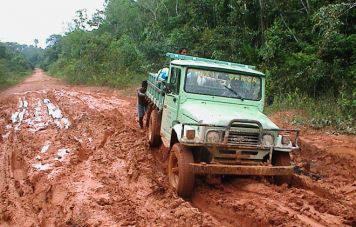 Departure from São Gabriel da Cachoeira <1> at 8 am on board Toyota Jeep 4 × 4 to hit the dirt road to Frente Sul. Estimated travel time for the 85 km is 3 hr. Boarding of canoes on the Iá mirim river <2>, which after about 30 minutes funnels into his brother, the bigger Iá river. After 1:30 pm the Cauaburi river is reached <3> and after another 3 hr canoe ride on the Cauaburi we arrive at the Maturacá channel and moor the canoes. Now a camp is pitched on safe location on the river banks to avoid that, after heavy rains on the river head sudden downstream swells might wash the camp away. We are going to pick up our Yanomami guides and carriers at Maturacá village. They will join in for dinner which has been prepared in the meantime. Overnight will be in hammocks.
Departure from São Gabriel da Cachoeira <1> at 8 am on board Toyota Jeep 4 × 4 to hit the dirt road to Frente Sul. Estimated travel time for the 85 km is 3 hr. Boarding of canoes on the Iá mirim river <2>, which after about 30 minutes funnels into his brother, the bigger Iá river. After 1:30 pm the Cauaburi river is reached <3> and after another 3 hr canoe ride on the Cauaburi we arrive at the Maturacá channel and moor the canoes. Now a camp is pitched on safe location on the river banks to avoid that, after heavy rains on the river head sudden downstream swells might wash the camp away. We are going to pick up our Yanomami guides and carriers at Maturacá village. They will join in for dinner which has been prepared in the meantime. Overnight will be in hammocks.
Day 4
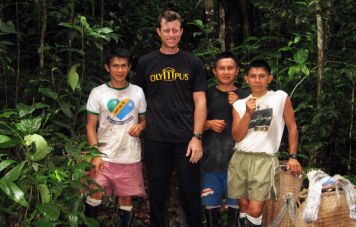 Departure from the camp at 8 am to the mouth of the Tukano river <4> which should be reached before noon. Canoes are moored, engines and gasoline are stashed away and the hike to the Pico da Neblina begins now. After 3 hr of mostly up and down hill hiking we arrive at a Yanomami plantation site called Cachoeira do Tukano. The Yanomamis maintain such plantations with Banana, Manioc, Lime and other fruits also to support their hunting groups in the forest. There is time for a refreshing bath in the river. You may also want to check fishing skills and eventually contribute some fresh fish for dinner. Overnight is either in hammocks or tents.
Departure from the camp at 8 am to the mouth of the Tukano river <4> which should be reached before noon. Canoes are moored, engines and gasoline are stashed away and the hike to the Pico da Neblina begins now. After 3 hr of mostly up and down hill hiking we arrive at a Yanomami plantation site called Cachoeira do Tukano. The Yanomamis maintain such plantations with Banana, Manioc, Lime and other fruits also to support their hunting groups in the forest. There is time for a refreshing bath in the river. You may also want to check fishing skills and eventually contribute some fresh fish for dinner. Overnight is either in hammocks or tents.
Day 5
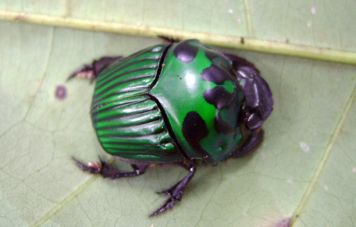 As usual, we breakfast and leave camp at around8 am, destination camp 3, called Bebedouro Velho <5>, which could be translated into the “old water supply” or “water source”. For the 12 km trail on pretty irregular terrain, requiring regular breaks, a total of 6 to 7 hr is estimated. The Bebedouro Velho is located at 400 m above sea level and offers splendid views of the Pico da Neblina and surrounding mountains. With the helping hands of our Yanomami guides the camp is pitched, fire lit and the dinner prepared. There is a wide choice of overnight options: hammock or tent!
As usual, we breakfast and leave camp at around8 am, destination camp 3, called Bebedouro Velho <5>, which could be translated into the “old water supply” or “water source”. For the 12 km trail on pretty irregular terrain, requiring regular breaks, a total of 6 to 7 hr is estimated. The Bebedouro Velho is located at 400 m above sea level and offers splendid views of the Pico da Neblina and surrounding mountains. With the helping hands of our Yanomami guides the camp is pitched, fire lit and the dinner prepared. There is a wide choice of overnight options: hammock or tent!
Day 6
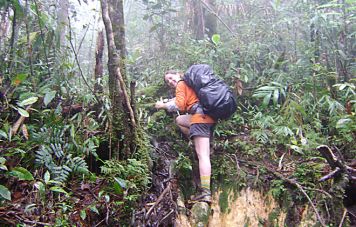 From the Bebedouro Velho, a difficult trail, with plenty of ups and downs gets us to the Bebedouro Novo <6>, or new water source or supply. A 460 m difference in altitude to the Bebedouro Velho, plus another 12.5 km of trail, sums up to a total of 860 m above sea level and 25 km of trail, making up an average of 6-7 hours of hiking for that stretch. The camp is pitched at a beautiful spot next to the Cuiabixi river, offering great bathing in the cascades, natural hydro massage for relaxation included. For the night we sleep again in the hammocks.
From the Bebedouro Velho, a difficult trail, with plenty of ups and downs gets us to the Bebedouro Novo <6>, or new water source or supply. A 460 m difference in altitude to the Bebedouro Velho, plus another 12.5 km of trail, sums up to a total of 860 m above sea level and 25 km of trail, making up an average of 6-7 hours of hiking for that stretch. The camp is pitched at a beautiful spot next to the Cuiabixi river, offering great bathing in the cascades, natural hydro massage for relaxation included. For the night we sleep again in the hammocks.
Day 7
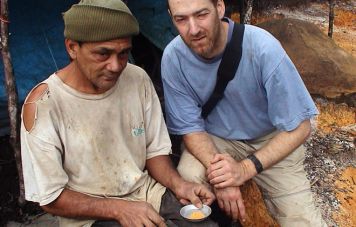 Today we have to negotiate a short but steep trail of 6 km only that brings us to an altitude of 2,000 m above sea level. As usual, we travel an average of 6-7 hours. The temperature drops and the vegetation changes on the way to the Camp Base <7>, situated below the peak of the Pico da Neblina. To get there, we will have to master, among a series other natural obstacles, like roots and trees and rocks and rivers, a swampy turf plateau where you get stock up to your knees with each step in the muddy terrain. After arriving and a well earned relax, the crew pitches the camp, while the others may want to visit the nearby camp of a lonesome garimpeiro (gold digger). On request, and to the disguise of the environmentalists and naturalists in the group, he will show how he washes the gold out of the rapid banks. No further activities are planned for the rest of the day, which certainly has been a very strenuous one for most of us.
Today we have to negotiate a short but steep trail of 6 km only that brings us to an altitude of 2,000 m above sea level. As usual, we travel an average of 6-7 hours. The temperature drops and the vegetation changes on the way to the Camp Base <7>, situated below the peak of the Pico da Neblina. To get there, we will have to master, among a series other natural obstacles, like roots and trees and rocks and rivers, a swampy turf plateau where you get stock up to your knees with each step in the muddy terrain. After arriving and a well earned relax, the crew pitches the camp, while the others may want to visit the nearby camp of a lonesome garimpeiro (gold digger). On request, and to the disguise of the environmentalists and naturalists in the group, he will show how he washes the gold out of the rapid banks. No further activities are planned for the rest of the day, which certainly has been a very strenuous one for most of us.
Day 8-14
Day 8
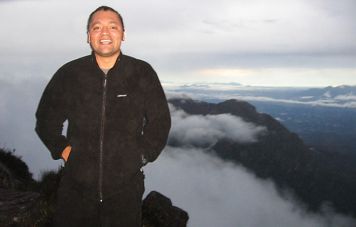 The last leg (6 km) to the top of the Pico da Neblina <8>, will take about 7 hours of heavy mountain trekking including 3 hours through swampy terrain, another 3 hours over a large plateau covered with loose boulder and rock, plus 1 hour climbing on the rope, for which technical climbing experience is not necessary. Provided everything running smoothly, a tired but happy group would arrive at the 2,994 m peak around 3 pm, with daylight at hand for admiration of the Imeri massif, and the infinite rainforest that stretches deep into the Venezuelan territory. Although neblina means fog, you may be lucky with the weather and be able to take some great photos of this magnificent environment. For overnight in the tents on the peak you will need a sleeping bag for low temperatures of up to -5º Celsius and warm clothing.
The last leg (6 km) to the top of the Pico da Neblina <8>, will take about 7 hours of heavy mountain trekking including 3 hours through swampy terrain, another 3 hours over a large plateau covered with loose boulder and rock, plus 1 hour climbing on the rope, for which technical climbing experience is not necessary. Provided everything running smoothly, a tired but happy group would arrive at the 2,994 m peak around 3 pm, with daylight at hand for admiration of the Imeri massif, and the infinite rainforest that stretches deep into the Venezuelan territory. Although neblina means fog, you may be lucky with the weather and be able to take some great photos of this magnificent environment. For overnight in the tents on the peak you will need a sleeping bag for low temperatures of up to -5º Celsius and warm clothing.
Day 9
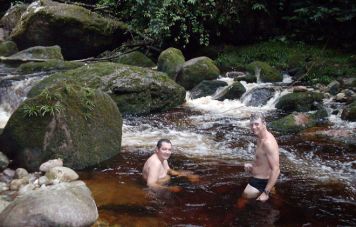 Decamp, packing gear and returning to descend to the Bebedouro Novo with arrival there estimated for 2 pm approximately. No further activities are planned for the rest of the day. Again there is the Cuiabixi river for great bathing and refreshing.
Decamp, packing gear and returning to descend to the Bebedouro Novo with arrival there estimated for 2 pm approximately. No further activities are planned for the rest of the day. Again there is the Cuiabixi river for great bathing and refreshing.
Day 10
An 8 hours hike always descending, straight to Cachoeira do Tukano, requires several breaks. An invigorating bath in the Tukano river after arrival there, will help to relax body and mind. Camp at the Cachoeira
Day 11
Further descend to the mouth of the Tucano river. Picking up engine, gasoline and other equipment and provisions that were left behind there, the canoe is loaded and off we are heading for the Yanomami Indian village of Maturacá. Arrival estimated for the end of the day. We will stay overnight with the Yanomami people in their traditional cabanas.
Day 12
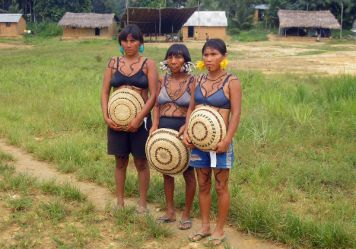 Today we will have the rare opportunity to visit the biggest Yanomami village on Brazilian territory, which host roughly 2,000 Yanomami people. We will meet their leaders and discuss issues of interest. The Yanomami handicraft, made by their women, is well known for its beauty and quality. We will be impressed by their dedication while watching producing artifacts from natural resources, mainly fibers, woods and clay. We will get to know, their way of living today and in the past, their traditions, their food and visit their manioc plantation to witness the process of production of flour, an essential diet for all Indians and most of the Brazilians in general. Particularly touching is the contact with their joyful children. The stay in Maturacá provides an insight view of the reality of the Brazilian Indians today and in particular of the famous Yanomami tribe.
Today we will have the rare opportunity to visit the biggest Yanomami village on Brazilian territory, which host roughly 2,000 Yanomami people. We will meet their leaders and discuss issues of interest. The Yanomami handicraft, made by their women, is well known for its beauty and quality. We will be impressed by their dedication while watching producing artifacts from natural resources, mainly fibers, woods and clay. We will get to know, their way of living today and in the past, their traditions, their food and visit their manioc plantation to witness the process of production of flour, an essential diet for all Indians and most of the Brazilians in general. Particularly touching is the contact with their joyful children. The stay in Maturacá provides an insight view of the reality of the Brazilian Indians today and in particular of the famous Yanomami tribe.
Day 13
Via the rivers Cauaburi, Greater Iá and Iá-Mirim we return to the Frente Sul, Southern Front, where our jeep takes us back to the town of São Gabriel da Cachoeira, with arrival estimated for the late afternoon. At the hotel “Deus me deu” or “Given by God” a hot shower is waiting. Dinner tonight will be at the best Restaurant in town. A real bed and air condition will guarantee deluxe accommodation for the last night, which hopefully you did not miss while on expedition.
Day 14
We like to suggest what one could call in other places a city tour and do some walking around the town to get to know some of the history of the region and also to visit the Salesian church and the port area. Back at the hotel we must pack gear before we go for lunch and transfer than to the airport to take flight back to Manaus at 5:45 / 8:00 pm. Transfer to the Hotel.
Travelogue
Travelogue
Amazon Journey to the Northernmost Frontier of the Brazilian Rain- and Nebular Forest
Who went along: two adventurers from Germany, a botanist from the Goeldi Amazon Research Centre, our guide and 3 porters
Belém, the capital of the of Amazonian state of Pará, in the Northeast of Brazil, is strategically located at the 250 km wide delta of the Amazon river. Since its foundations in 1616, it is considered to be the historical gateway to the Amazon region. Religious and other edifications date back to the colonial period and are maintained in good shape. Obviously we had to visit some of the highlights Belém offers to tourist and locals alike. At the famous market, the Mercado Ver-o-Peso (checking the weight market), we marvel at the exotic products displayed there. Enormous quantities of all kinds of sea-and river fishes are being offered and we wonder why there are no flies on them despite of the tropical heat all around us. There are also elixirs made from poisonous snakes and all imaginable and unimaginable kinds of medicinal herbs and fruits from the Amazon region.
We also visited the internationally renowned Goeldi Amazonian Research Institute with its botanical-zoological gardens representing exclusively species of that region a glimpse of the flora and fauna that we were to discover in the weeks to come...
We also took a trip on the Guamá river where we enjoyed typical food in one of the palm thatched restaurants, surrounded by luxurious nature. In the evening we went down to the harbour. The old piers and warehouses have been restored with shops, fancy bars and restaurants. Cargo cranes moved platforms back and forth under the ceiling, with artists performing excellent music shows. While we sat on the terrace in front of the river, we enjoyed draft beers made in the probably only in-house brewery of the whole Amazon region. A last delight before we should hit wilderness and suffering!
The following morning we took a flight to Manaus, the capital of the federal state of Amazonas. We had made plans to try to observe the South American jaguar Panthera onca at a spot some 80 km away from Manaus. To our disappointment we received information that, due to restrictions imposed by IBAMA, we were not permitted to enter the site. So we took the early flight on the next day to São Gabriel de Cachoeira where we arrived after two hours of flying over the "Green Hell" with its great and amazingly intricate river systems.
We checked in our modest hotel, to say the least, and walked over to IBAMA, the Brazilian Institute for the Environment to get permits for our expedition. We repeated the procedure at FUNAI, the Agency for the Protection of the Brazilian Indians, because our route leads across both the 2,200,000 hectares large national park of the Pico da Neblina and the Indian reservation area of the same name.
The village on the upper Rio Negro was founded in the middle of the 19th century as a military settlement and a Salesian mission. Today it consists of not much more than a Portuguese fortress with some dozen houses for soldiers and officers. The centerpiece of the village used to be the thatched church built in 1750, and which, since the beginning of the 20th century is the seat of the Salesian mission. The Brazilian Army and Air Force, supported by the federal police keep their jungle regiment here to safeguard the borders with Venezuela and Columbia and to track down on the intense drug and arms traffic in the area. The population consist in its majority of indigenous people of several tribes of the upper Amazon region.
The following morning, carrying all equipment, food and fuel supply, we work our way up by jeep along a treacherous jungle track to the mouth of the Rio Iá mirim. Final balance of the three-hour trip: stuck in the mud for six times!
After we stuffed our equipment and all our belongings into an aluminium boat and were ready to depart, the engine only whines out of pace and despite of all efforts, refused to do his job. Via satellite phone we ordered an extra engine for replacement, which postponed our departure for the following morning.
We used the time to visit the Indian settlement of the Tukano tribe, only a short walk away. We were shown how the main diet of all Indians in Brazil, the manioc roots, is being prepared by using different handcrafted tools. At the conviviality centre, the tribe gathers to discuss important day-to-day issues, as well as questions of social and political importance. The children receive bilingual education in their native and Portuguese language. School activities include both traditional cultural heritage and preparation for a life within a modern society. Apparently the kids had no problems to absorb these contradictions as they all looked happy and were very friendly toward us. In short, we gained a very interesting insight into the social organization of the tribe.
Common to the different tribes in the upper part of the Rio Negro is the language called Inheengatu, also known as general language which is spoken together with Portuguese. The Indians tribes of the upper and middle Rio Negro comprehend 18 ethnical groups with a total of about 35,000 Indians who live in 772 small villages. The largest and best known tribe is that of the Yanomamis, who alone live in a protected area of over 100,000 km².
We walked back to the Iá mirim river and prepared camp for the night at theFUNAI support base, right on the river banks. But before we could hit our hammocks we decided to undergo some serious testing of our skills as jungle adventurers. Incited by our hosts we took charge of some of the dugout canoes that lay around, but all our attempts resulted in total disaster. Those canoes are so shallow and small that at the slightest false movement they get filled with water, sinking in no time while the Tukano Indians on the shore shake with derisive laughter. Little wonder, as only they knew that in addition to our lack of awkwardness, the canoes leaked like hell from a couple of tiny holes that were invisible to us! Anyway, one:nil to the Indians! While recovering from our heroic efforts, Yanomami Indians arrived in their motorized canoes busily offloading ornamental fish of exotic colours and forms. Very appreciated by Ichthyologists the fish have been caught on the upper Tukano river and are being exported to everywhere in the world.
As we were standing there watching, one of us nearly stepped on a huge and hairy spider, the size of a palm. That nocturnal animal, scientifically named Theraphosa leblondi is the biggest spider in the world. Its life span may reach up to 20 years and it lives mainly in caverns of old tree trunks. Provoked it would jump on you and its bite causes terrible pain, but is not fatal.
The next morning greeted us with hundreds of yellow butterflies, that fluttered all around us. Unfortunately we could not identify them. The new engine arrived right after breakfast and we could now get started. With the boat fully loaded, a crew of eight people and all the equipment, we travelled first downstream on the Rio Iá mirim, then on the Rio Iá and finally upstream on the Rio Cauaburi to the mouth of the Rio Tukano.
We spend two days on this trip through breathtaking nature, on igapó (submersed jungle), várzea (temporarily submersed land bordering a stream) and terre-firme (an elevated portion of the terrain, above the inundation level) forests, surrounded by the ever present sounds of the jungle.
Our first acquaintances are rather unpleasant insects, called piums, stinging mosquitos just the size of a pinhead, which reveal themselves as a terrible plague. But we also see countless birds: black-necked araçaris, toucans, yellow breasted, scarlet and green wing macaws, plus several kinds of herons and kingfishers flew across the rivers and become our colourful travelling companions.
One afternoon on the Iá mirim a brilliant green water snake blocked our way trying to get across the river. So we carefully got closer to take a picture. The snake swam towards to trees on the river bank and twisted itself impressively fast up on the lianas mingling with the green leafs and branches and could be seen no more.
We fixed camp at the mouth of the Tukano river, hided the boat, gasoline and rations for the return journey and slept, protected by Citronella insect lotion, under clouds of piums. Some dreamed of spiders and snakes others of butterflies and macaws...
Three days of tough and steady uphill trekking lay ahead with difference in altitude from 150 meters to up to 2,994 m NN. We toiled our way six to seven hours daily along hardly recognizable trails that have been opened by Yanomamis and gold diggers. We stepped on root entanglements covered up with slippery foliage, jumped over crystal clear rapids that supply us with fresh drinking water, and climbed waterfalls that seemed to fall out of an impenetrable green wall before us. To relax muscles and mind, there is nothing better than a refreshing bath under a waterfall or a plunge into some rapids.
The beauty and the power of the jungle was present at every step we took uphill. We felt like gnomes next to well over 30 meters high jungle giants and identified huge rubber Hevea brasiliensis and Brazil nuts trees Bertholletia exelsa. It gets very hot and sunny from early in the morning with well over 90 % air humidity until the afternoon, when the accumulated heat breaks out into heavy rainfalls.
At night we sleep in hammocks and in tents; that is the time when the nightly noises of the jungle always make us feel that we are not alone. And actually, as we later are informed, several jaguars roam here about in their hunting domain.
On the second day, one of the participants feels exhausted and gives up. We left him behind with one of the porters in a Yanomami hunting camp and went on. At about 1,600 m.s.l. the dense rainforest started to change into the more open but very humid nebular mountain forest.
In the evening of the third day, under heavy rain and the cold temperature of 5 Celsius, enhanced by humidity, we arrive at the gold prospectors camp beneath the mountain peak. To get there we had to face a soft humus morass, that took us 2 hours to traverse as we were sinking knee-deep at every step. Here a natural, paradisical garden is formed by the different sorts of bromeliads, orchids, mosses and an amazing number of endemic carnivorous plants. On the same plateau at 2,100 m.s.l. also rare medical plants can be found. Under rather precarious circumstances we prepare our camp. To get some relief against the bitter cold we now surely would appreciate a swig of our precious cachaça booze made of sugar cane that came all the way from Rio de Janeiro. To everybody's surprise and disappointment it had miraculously disappeared. But exhausted as we were, sleep would come fast this night.
The next day a difficult decision was to be made: shall we venture climbing up to the peak under the present weather conditions? It is raining so heavily that the peak of the Pico da Neblina is covered with white cascades of enormous masses of water that are also running down on the paths that we are supposed to take. For safety reasons we unanimously decide not to venture the climbing to the 2,994 meters high peak.
It has been decided instead to use the time on the plateau to explore the area together with our botanist, who identified and collected orchids, like Scuticarias, also called whip orchids, the rare Coriantes with their bizarre flower and the intensely yellow Cataseto, all fully blossoming and botanical highlights – a real treat for our specialist in epiphytes.
We also visited the only gold prospector left in an area that used to be one of the most prosperous sites in Brazil. But since the Pico da Neblina is part of the Indian reservation, Federal Police and the military cracked down on the illegal activities that came to an end during the last decade. The lonely man showed us his self-made installations, by which he obtained gold from a particular layer of mud and rock in the slopes, washing them out with powerful jets of water from the rapid that rushed down from the peak. Questioned about the resulting environmental devastation that he is causing, he looked at us as if we had just arrived from mars. His modest accommodation was like that of a caveman and his way of living seemed not far from that too: the only pot he's got for his meals he shared with his chickens. With the obtained gold he pays for his food and equipment, brought regularly up by Yanomami Indians from their village in Maturacá. There he also deposits the remaining gold to save for his uncertain future.
On the way back to our camp we were taken by surprise by a violent storm which flooded the river that we had to cross. There was not a chance to do so now and, with a machete we beat a path through the bushes, at times up to our hips deep in the morass. Somehow we finally reached our camp, only to see that the tents, as well as our sleeping bags that we had hung out to dry in the rare sun when we left, are now soaking wet: at almost 0 Celcius, a sure promise for a rather uncomfortable night!
We were still shivering from the frosty night but the morning sun gently warmed up our bodies. After dismantling the camp we start our not less difficult way back, picking up our expedition participant who had been left behind. In the late afternoon of the third day we are again at the mouth of the Rio Tucano, where we had hidden our boat with the rest of the food and fuel supply.
In spite of the constant heavy rain that smashed into our faces, we decided to start our journey back on the rivers right away. After a couple of hours, already on the Rio Cauaburi, we were lucky to meet a Yanomami hunting group just busy smoke-curing their freshly killed wild animals and fish. An excellent opportunity to enhance our food supply mainly consisting of beans, rice, jerked meat and pasta and that was also getting scarce. Real delicacies against real money a pig sized paca, a bare-faced curassow, a nine-banded armadillo and a brown capuchin monkey, besides lots of delicious fragrant fish from the nearby igarapé waterway, all for R$ 30!
Happy and satisfied that we were, we tried to reach our camping place that we had chosen for the night. But since surprises is what a real adventurer looks for, the place had disappeared in the masses of water of the flooded river and with no alternative in view, we are forced to move on to the FUNAI post still far away. With flash lights, at a very slow pace, we feel our way through deep darkness during two hours, until the flashing signals of the Indian protection institute safely usher us through the rapids to the anchorage.
After another day on the rivers Iá and Iá mirim we reach our departure point, this time under bright sunshine, but not before undergoing a final physical and nervous fitness test: right after turning into a side arm of the river with strong current against us we run out of fuel .The whole crew immediately grab plates and whatever suitable objects were at hand and start rowing like hell against the current – one metre forward and two backward. It is then that one of the guides miraculously gets some more drops of fuel out of one of the bins making it possible for us to reach the FUNAI anchorage, just 200 meters ahead.
We slept one more night in the hammocks at the FUNAI support base and return the following morning by jeep to São Gabriel de Cachoeira. This time we got stuck in the mud only 5 times. One of the participants however hasn't had enough yet, and wanted to walk up to the Morro dos Seis Lagos (Mountain of the Six Lakes), a bio reservation and geologically very interesting area for the biggest niob beds in the world lie here underneath the soil.
Three days later we are together again and fly back to the jungle metropolis Manaus where we completed a classical sightseeing program. Very interesting are the old opera house, which flourished during the coutchouc boom and the colourful and bustling harbour with off-and on loading of the typical Amazon cargo and passenger ships canoes and boats in all sizes, that arrive at the harbour and depart in all directions to the most distant destinations in the region.
A short stay in Rio de Janeiro de completed a fascinating journey, replete with adventures in a world so far removed and different from ours. A world where the simple things have remained of great importance. Encounters with the forest, the rivers, the mountains, the animals and last but not least with the local people, our guides and porters, enriched all of us. One of our best trips ever – the German guys commented.
Prices & Details
Prices and Travel Details
| Travel Time | 14 days / 13 nights | ||
|---|---|---|---|
| Group Size | minimum 2, maximum 6 participants | ||
| Travel Dates 2020 | February 17–28 August 08–21 September 12–25 October 10–23 November 07–20 | ||
| Prices | 2-3 persons | 5,785 € | per person |
| 4-6 persons | 5,135 € | per person | |
| Price valid as from Manaus | |||
The price includes:
- Overnight with breakfast in double rooms or single rooms in Manaus and São Gabriel da Cachoeira (2)
- Transfers, overnight and activities in Manaus
- All transfers
- All meals and non alcoholic beverages
- Expedition equipment, tents and hammocks, cooking gear
- Canoes, conductors, gasoline
- Experienced, qualified expedition leader and reliable Yanomami and Tukano or Baré indigenous guides and carriers
- Contribution to NOTIWA Foundation (Future Yanomami)
- National park entrance fee
Our services start and end in Manaus.
The price does not include:
- International and domestic air fares
- Alcoholic beverages and tips
Payment conditions
Upon confirmation a deposit of 30 % to our German bank account becomes due. The rest has to be deposited on our account 40 days before beginning of journey. The dead-line for reservations is 90 days.
Difficulty Level
The trekking is strenuous, with difficult terrain covered with roots, swamps, mud, rocks, wet stone, river and rapid crossing, walking on rope to the peak. Very good physical conditions endurance and stamina are required.
Climate
Equatorial, average 80 % humidity, hot average +25° C, precipitation 3,496 mm/year! At higher altitudes the climate is foggy and very humid.
To Bring and Clothing
Clothing should include two set of shorts, shirts with long sleeve, light cotton socks, swim wear, several sets of t-shirts and underwear, rain cape, warm clothing for the night. High leather bootlegs with corrugated sole and solid grip are recommended for hiking and solid rubber trekking sandals to ford or bath in creeks, streams...
Equipment: 2 backpacks (70-100 / 35-50 l) as main baggage is stored in São Gabriel, sleeping bag, thermoflask, binocular, photo equipment, flash light, swiss army knife, personal cutlery, hut, sunglasses, insect repellent.
Only personal belongings (5-8 kg) have to be carried during the expedition by each participant.
Health
Vaccines mandatory: yellow fever, hepatites, tetanus.
Vaccines not mandatory: malaria prophylaxis.
Drinking water
From creeks and rapids, using of desinfection products recommended.
First aid
Granted by guides, bring your personal medicine.
Communication
Global Star satelite telephone
Meals
Salted, smoked and canned meat , fresh fish, ready made soups,rice, pasta, dehydrated vegetables, crackers, cookies, bisquits, banana and guava sweets, coffee, tea, dry milk
Disclaimer of warranty
This journey has the character of an expedition. Rivers and rainforest replace highways, streets and roads. The conditions which are encountered on route will be completely new for the traveler. A correct attitude and mental preparedness for a different and fascinating environment is imperative. The unexpected can happen, whereupon the traveler is expected to react flexible and, depending on the situation, relaxed or immediately. The guides with their knowledge of the environment, are experienced trekkers and expedition leaders and absolutely reliable. The willingness of the traveler to cooperate and interact tolerantly with other participants is required also in strenuous situations. As operator we disclaim ourselves of any warranty for any risk during this journey.
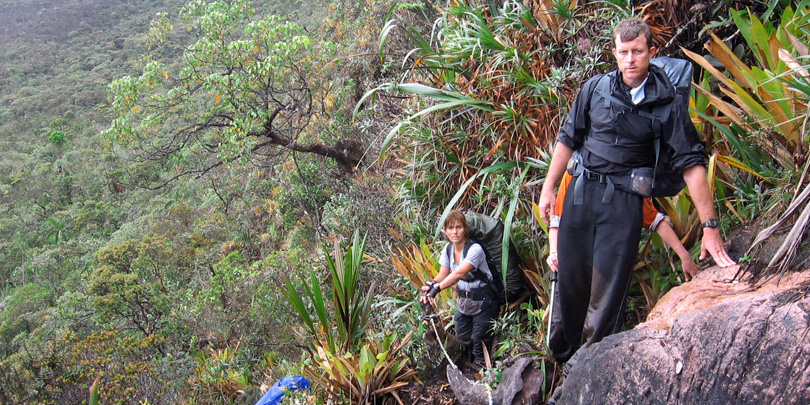
Comments
Ginge Fullen
Hi Peter,
Back in the land of showers (Manaus).
Great trip. Branco did a great job and the team of porters are especially good. Augustino the head porter is a great asset to you to use again as they all are.
Got a day left in San Gabriel so just a quick email now to saw thanks again.
Cheers Peter. Will pass your info to a few people who are interested in the trip.
Ginge Fullen
Stefan Rückert
Hello Peter,
maybe I will write a more detailed report after a while of reflection. For now just that: After 40 years of trekking experience your Pico da Neblina Tour will maintain an outstanding position in my travel memories.
In the first place because of your head guide Branco, a clever fellow, who never lost his good mood and arranged for food even at the remotest places.
And obviously our yanomami team for whom our well being was first priority on their service list. Last not least Sergeant Paulo, our supervisor who eat most of our provisions, who´s jungle experience and physical strength combined with always positive and radiant vibes, was another benefit to the tour.
I will also not forget the stay at the yanomami village in Maturaca where coincidentally the "Festa da Banana" was held. I felt very welcomed there.
That is all for now, again many thanks Peter that you made this "backpackers classic" possible for me.
Stefan Rückert